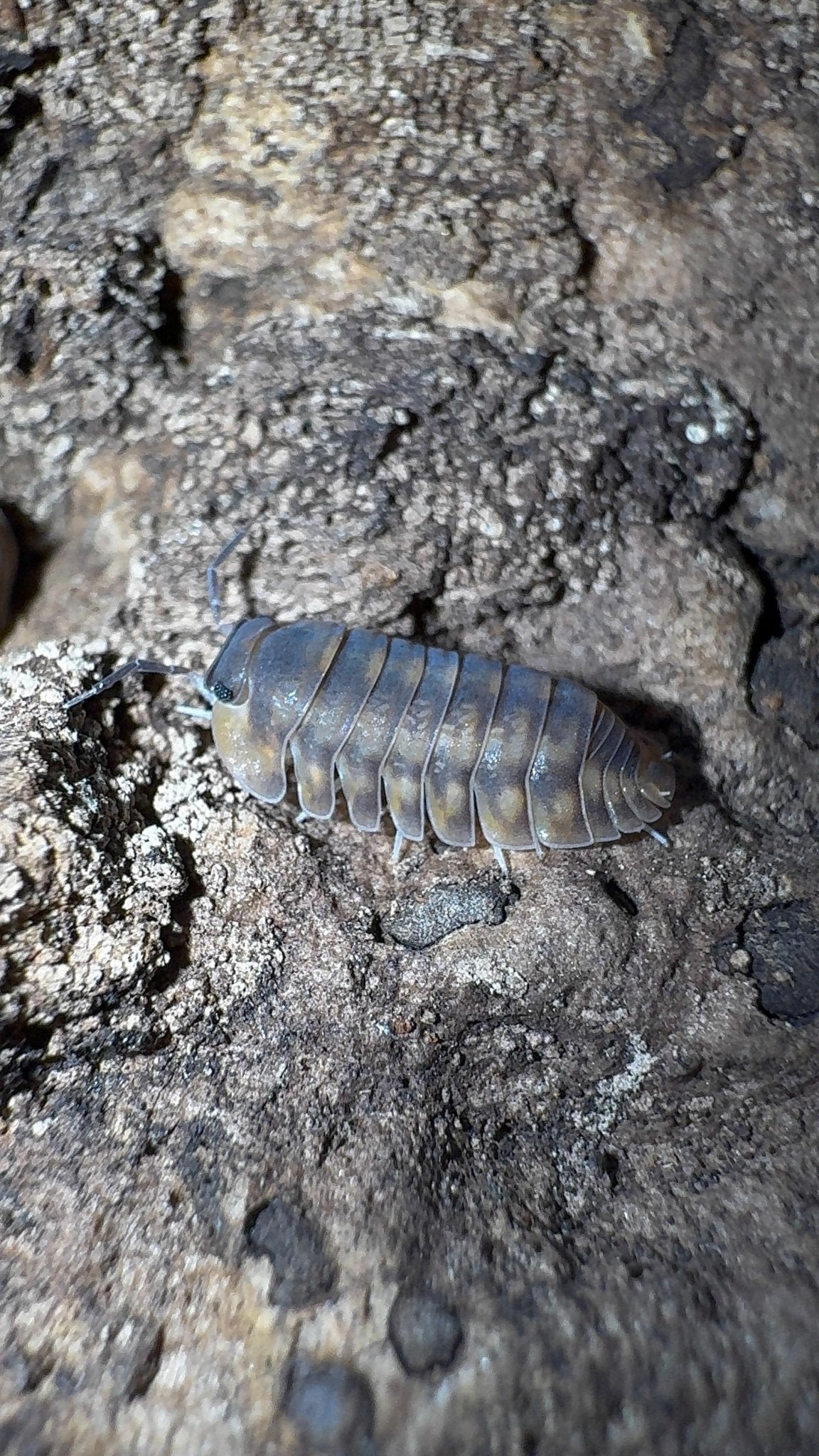A woodlouse is a small crustacean found under logs, stones, and decaying wood. They help recycle nutrients by feeding on decomposing materials. In this article, you’ll learn how to identify woodlice, different species, their habitats, behaviors, and their role in ecosystems.
Key Takeaways
-
The common woodlouse (Porcellio scaber) is vital for nutrient recycling, feeding on decomposing organic materials and aiding soil health.
-
There are approximately 30 different species of woodlice in the UK, each with unique physical characteristics and habitat preferences.
-
Woodlice are crustaceans and not insects; they play a crucial role in ecosystems, and their populations indicate environmental health.
Meet the Common Woodlouse

The common woodlouse, scientifically known as Porcellio scaber, thrives in damp environments, often found under stones, logs, and decaying wood. These resilient creatures are not just ubiquitous but also play a vital role in nutrient recycling by feeding on decomposing organic materials. This process helps to break down dead plant and animal matter, returning essential nutrients to the soil and supporting the ecosystem.
In the UK, the uk common woodlouse is a familiar sight in gardens, forests, and even urban areas. They are particularly active in moist, shaded locations where decaying wood and leaf litter are abundant. Their presence is a good indicator of a healthy, functioning ecosystem, as they help to break down organic matter and maintain soil health.
Identifying the Common Woodlouse
Spotting the common woodlouse is easy once you know what to look for. These creatures typically have the following characteristics:
-
Oval-shaped body
-
Length of about 1.5 centimeters
-
Smooth, shiny exoskeleton that is grey with yellow patches and lighter grey edges
-
Body composed of seven segments
-
Each segment has a pair of legs, giving them a distinctive segmented appearance, including a few common woodlouse.
Woodlice often seek out decaying wood and other moist environments, including damp places. Their preference for these habitats helps them avoid drying out, as their exoskeleton is not entirely waterproof.
Keep an eye out for these small but mighty recyclers in your garden or local park, often hiding under stones or within leaf litter, where they can hide from predators.
Different Species of Woodlice
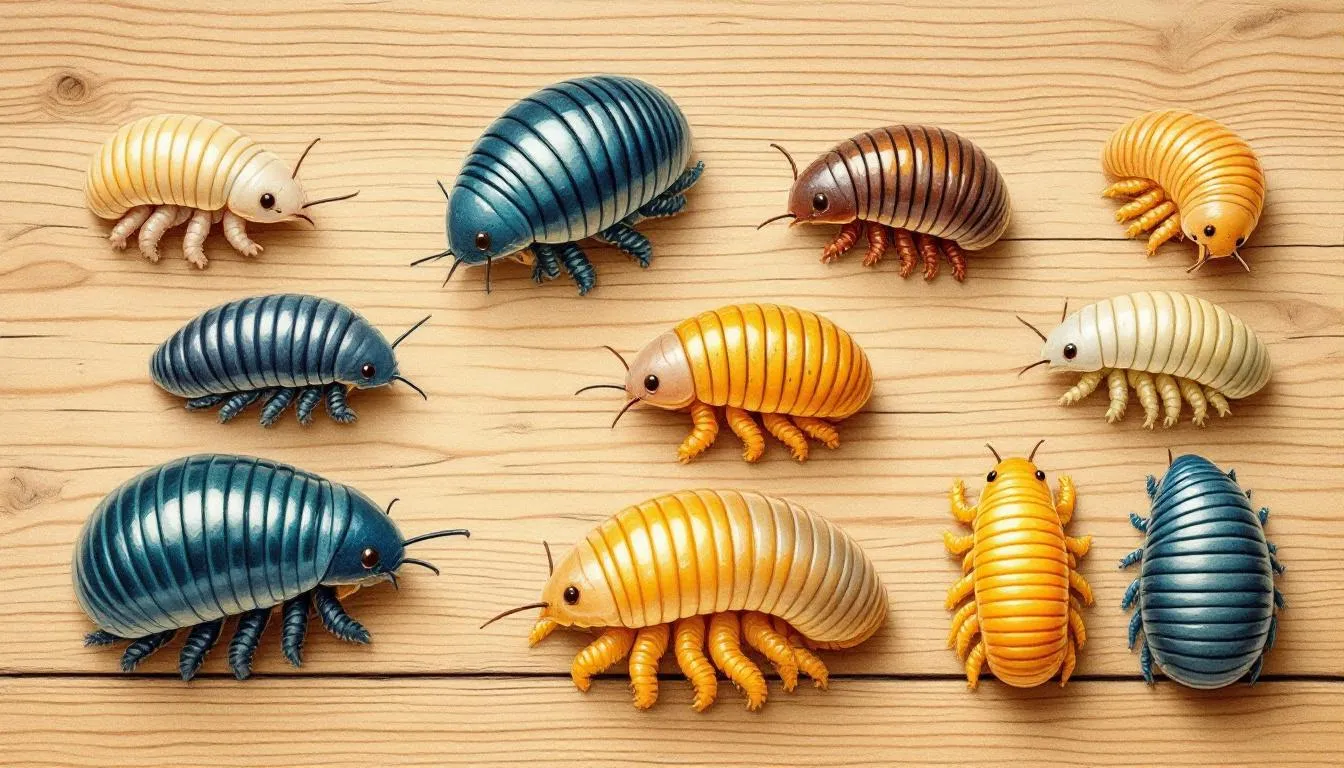
The diversity among woodlice is truly remarkable, with approximately 30 different species found in the UK alone. Each species has its unique characteristics and preferred habitats, making them an interesting group to study.
Here are some common species you might encounter, along with their physical attributes, behaviors, and habitats.
Common Shiny Woodlouse
The Common Shiny Woodlouse, as the name suggests, has:
-
A smooth and shiny grey body adorned with light patches and sometimes yellow flecks
-
A size of up to 16mm in length
-
A preference for damp habitats, often found under logs and in wood piles where you can find common rough woodlice
-
Juveniles with a slightly rougher texture compared to their smooth adult counterparts
These woodlice are particularly adapted to moist environments, which help them avoid dehydration. You can often spot their shiny exoskeletons glinting in the light as they scuttle away to find shelter.
Pill Woodlouse
The Pill Woodlouse is distinctive for its ability to roll into a ball when disturbed, protecting itself from predators. Usually uniform grey with yellow mottling, they can grow up to 18mm in length and typically reside under leaves on the woodland floor or on walls.
Observing these woodlice is fascinating, especially when they curl into a tight ball, resembling a pill. This unique defense mechanism sets them apart from other species, showcasing the incredible adaptability of woodlice.
Rough Woodlouse
The Rough Woodlouse, unlike its shiny counterparts, has a textured exoskeleton and prefers drier environments such as leaf litter or stone walls. Common rough woodlice can grow up to 17mm in length and are commonly found in areas that offer some shelter but are not overly damp.
Their rough texture and preference for drier habitats make them more resilient to dehydration. These woodlice are often seen scurrying along stone walls or hiding within leaf litter, demonstrating their ability to thrive in various environments.
Common Pygmy Woodlouse
Measuring about 5mm, the Common Pygmy Woodlouse is one of the smallest species. Their reddish-brown color allows them to blend seamlessly into leaf litter.
Despite their tiny size, they are crucial to their ecosystems, contributing to decomposition.
Common Striped Woodlouse
The Common Striped Woodlouse is easily identifiable by:
-
Its yellowish-brown body with a dark stripe down its back
-
A black head
-
Growing up to 11mm in length
-
Preferring slightly drier sites such as wood piles, leaf litter, and grass
-
Being known for their speed and often seen quickly scurrying away when disturbed.
Their quick movements and distinctive coloration make them fascinating to observe. They are adept at avoiding predators, thanks to their speed and ability to blend into their surroundings.
Habitat and Behavior
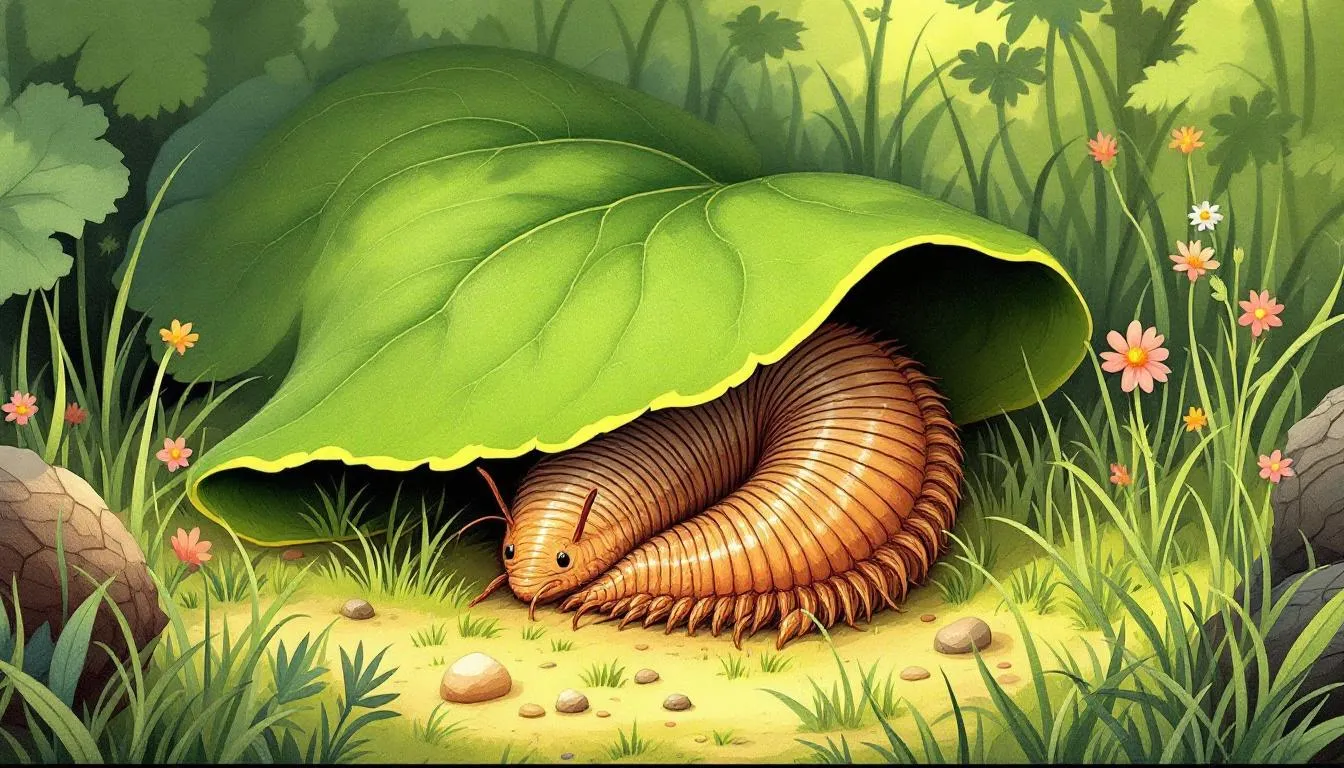
Woodlice are incredibly adaptable creatures, found in a variety of habitats across the UK. They thrive in damp areas rich in decaying plant matter, a major part of their diet. Primarily nocturnal, these crustaceans forage for food under the cover of darkness to avoid dehydration and predators.
During the day, woodlice seek shelter under stones, decaying wood, and leaf litter to conserve moisture and avoid the drying effects of the sun. By burrowing into leaf litter or hiding in crevices, woodlice can maintain the moist environment they need to survive.
Diet of the Common Woodlouse
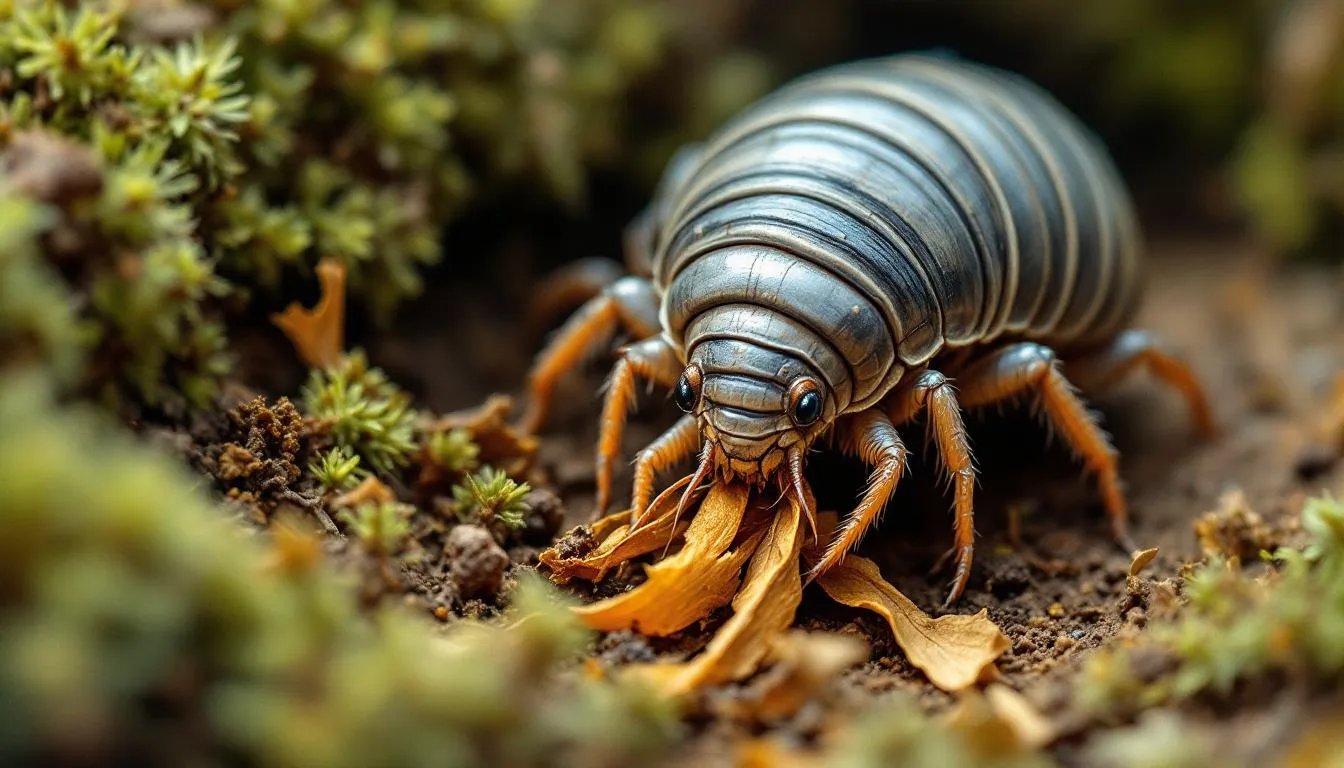
The common woodlouse’s diet is diverse, primarily consisting of:
-
Decaying wood
-
Leaf litter
-
Fungi
-
Dead animals
They are vital in breaking down organic matter, contributing significantly to decomposition and nutrient cycling. They can also eat their own faeces, which helps in recycling vital nutrients.
By feed on various organic materials, woodlice play an essential role in their ecosystems. This process:
-
Recycles nutrients
-
Maintains soil health and fertility
-
Supports plant growth
-
Ensures overall ecosystem stability
Breeding and Lifecycle
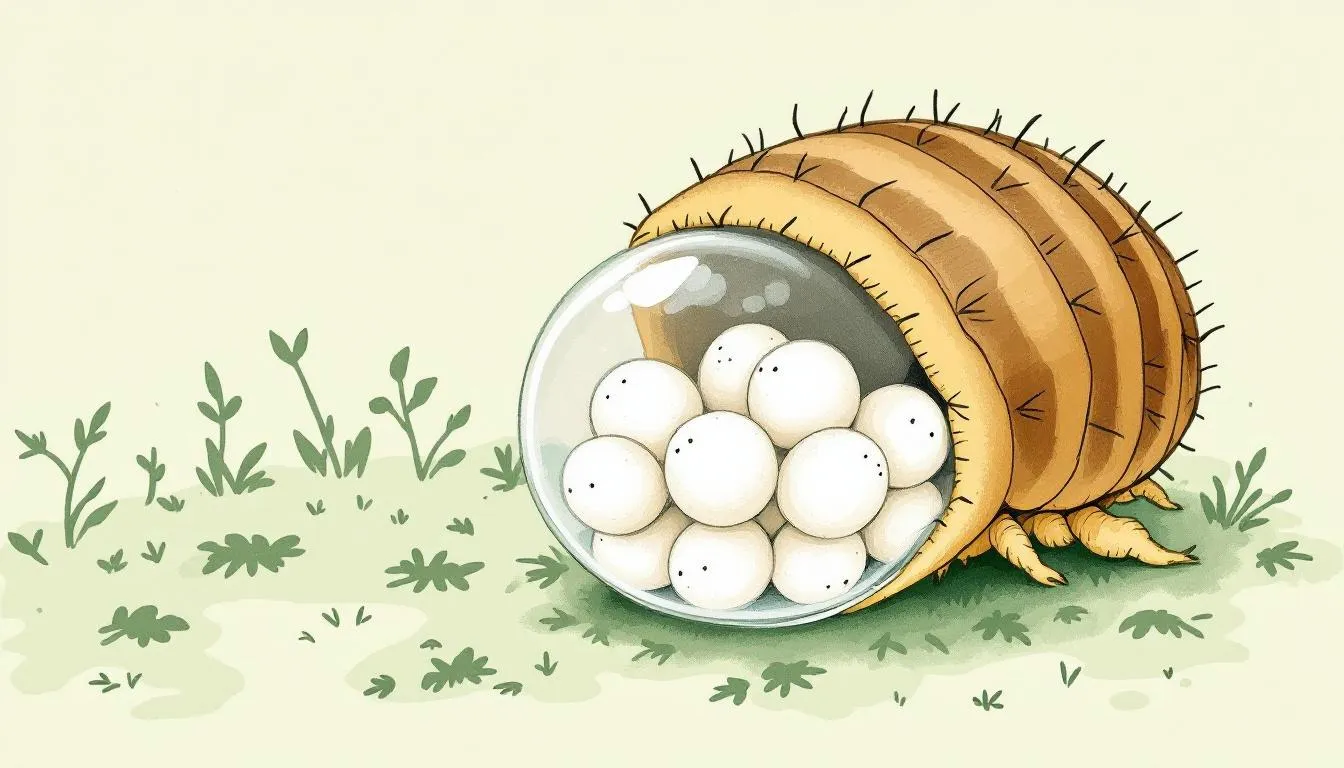
Woodlice have a fascinating breeding process:
-
Female woodlice carry fertilized eggs in a brood pouch for 40 to 50 days before hatching.
-
Similar to marsupials, this adaptation allows the young to develop in a protected environment.
-
Woodlice can produce multiple broods each year, with up to three clutches possible.
Juvenile woodlice stay with their mother for a few months after hatching, benefiting from her care until they reach sexual maturity at around three months. During this period, they undergo several molts, gradually developing into fully mature adults ready to continue the cycle.
Interesting Facts
Woodlice are not insects but belong to the class Crustacea, making them closely related to crabs and shrimps. Interestingly, woodlice can emit ammonia gas when in groups, earning them the nickname ‘stinky pigs’. This emission produces a distinctive bad smell, unusual for such small creatures.
With seven pairs of legs and multiple body segments, these terrestrial crustaceans have enhanced movement and flexibility. Their ability to avoid drying out by hiding in moist places, combined with their nocturnal habits, makes the isopod group fascinating subjects for study and observation.
Conservation Status
The common rough woodlouse has a stable population in the UK. Currently, it is not at risk. Their widespread presence indicates a healthy and thriving population. However, conservation measures are necessary to protect their habitats and ensure their continued stability.
Transported globally by humans, woodlice can now be found on every continent except Antarctica. This widespread distribution showcases their adaptability and resilience, underscoring the importance of habitat conservation to maintain their populations.
Local Names and Cultural Significance
Woodlice are known by various local names in different regions. In England, they are often referred to as ‘wood pig,’ highlighting their role in the ecosystem and their somewhat pig-like appearance.
Local names and cultural references add to the charm and intrigue of these small but important native mochyn coed creatures and other places, including hardy minibeasts, highlighting their origin.
Summary
In summary, woodlice are fascinating creatures that play a crucial role in our ecosystems. From their diverse species and unique behaviors to their vital role in nutrient recycling and their stable conservation status, woodlice are truly remarkable. By understanding and appreciating these hardy minibeasts, we can better appreciate the intricate balance of nature they help maintain.
Frequently Asked Questions
What is the primary role of woodlice in the ecosystem?
Woodlice serve a vital function in nutrient recycling within ecosystems by consuming decaying organic matter, thus facilitating the breakdown of dead plant and animal material and replenishing essential nutrients in the soil.
How can I identify a common woodlouse?
To identify a common woodlouse, look for its smooth, shiny grey exoskeleton with yellow patches and lighter grey edges, along with its oval shape and a size of up to 1.5 centimeters in length.
Where are woodlice typically found?
Woodlice are typically found in damp environments, such as under stones, logs, and decaying wood, where they can maintain moisture and avoid dehydration.
What do woodlice eat?
Woodlice primarily consume decaying organic matter such as wood, leaf litter, fungi, and dead animals, which plays a crucial role in their ecosystem by aiding decomposition.
Are woodlice endangered?
The common rough woodlouse is not endangered and maintains a stable population in the UK. Nevertheless, it is crucial to implement conservation measures to protect their habitats.


